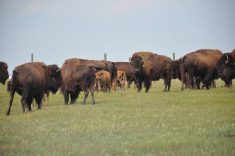A University of Alberta research team has found a new way to turn animal protein into plastic, which could divert thousands of tonnes of specified risk materials away from landfills and produce useful bioplastic.
Some bioplastics have not worked well in the past but researcher David Bressler said the Alberta team has discovered and patented a technique to make a strong plastic for industrial uses.
“Many of the renewable plastics are made from things like starch,” said Bressler.
“We are using a material that has a cost and an environmental impact so we see that we are in a much better position than almost any other renewable plastic out there,” he said.
Read Also

Trump’s tariffs take their toll on U.S. producers
U.S. farmers say Trump’s tariffs have been devastating for growers in that country.
Since shortly after the discovery of BSE in Canadian cattle, packing plants have been forced to remove the cattle parts thought most likely to harbour the prions responsible for causing the disease.
However, it is costly to remove the brains, spinal cords and glands and send them to a landfill.
The Alberta Prion Research Institute, PrioNet Canada and the Alberta Livestock and Meat Agency have funded Bressler and his team in their quest to add value to byproducts from the beef business.
Bressler has a background as a chemical biologist and chemical engineer and started working on the project in 2005.
Working with the rendering company Sanimax, the researchers used thermal hydrolysis to reduce SRMs to a black, tarry, smelly material. They then analyzed the chemical composition, which included a high level of protein.
“It took us about two years to figure out the nature of the chemistry of the material,” he said.
The next step was to find a way to extract the protein and put it to good use. The result was peptides or small pieces of protein that could be bound together to form a rigid structure.
“They’re not really proteins anymore, they are really just little reactive things,” he said.
The new plastics from Bressler’s lab are being tested by the Woodbridge Group, a car parts manufacturer. Funding is now aimed at research to see if the plastics can be mixed with renewable fibres such as hemp. If successful, the resulting biomaterial could be used in high strength materials such as building structural supports or car parts.
“The reason we targeted them is they tend to have some of the highest requirements for their materials,” he said.
“If we can meet their application requirements that is great because that is a start with plastics that are used for packing materials, deck building material,” Bressler said.
They may not all be high value plastics but are worth more than SRMS dumped in a landfill.
Bioplastics are like biofuel where quality varies so the recipe is constantly being tweaked to make a better product.
“We are pushing this as far as we can to really understand the fundamentals and properties and tweaking it. When we do commercialize it, it is going to be a high quality material,” he said.
They are making brown plastic now and if researchers can find a way to remove the colour and produce a clear product, it would have even higher value.















